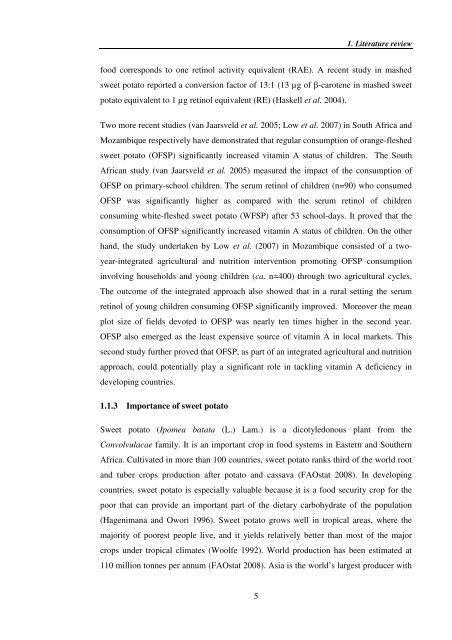Investigating carotenoid loss after drying and storage of
Investigating carotenoid loss after drying and storage of
Investigating carotenoid loss after drying and storage of
You also want an ePaper? Increase the reach of your titles
YUMPU automatically turns print PDFs into web optimized ePapers that Google loves.
5<br />
1. Literature review<br />
food corresponds to one retinol activity equivalent (RAE). A recent study in mashed<br />
sweet potato reported a conversion factor <strong>of</strong> 13:1 (13 µg <strong>of</strong> "-carotene in mashed sweet<br />
potato equivalent to 1 µg retinol equivalent (RE) (Haskell et al. 2004).<br />
Two more recent studies (van Jaarsveld et al. 2005; Low et al. 2007) in South Africa <strong>and</strong><br />
Mozambique respectively have demonstrated that regular consumption <strong>of</strong> orange-fleshed<br />
sweet potato (OFSP) significantly increased vitamin A status <strong>of</strong> children. The South<br />
African study (van Jaarsveld et al. 2005) measured the impact <strong>of</strong> the consumption <strong>of</strong><br />
OFSP on primary-school children. The serum retinol <strong>of</strong> children (n=90) who consumed<br />
OFSP was significantly higher as compared with the serum retinol <strong>of</strong> children<br />
consuming white-fleshed sweet potato (WFSP) <strong>after</strong> 53 school-days. It proved that the<br />
consumption <strong>of</strong> OFSP significantly increased vitamin A status <strong>of</strong> children. On the other<br />
h<strong>and</strong>, the study undertaken by Low et al. (2007) in Mozambique consisted <strong>of</strong> a two-<br />
year-integrated agricultural <strong>and</strong> nutrition intervention promoting OFSP consumption<br />
involving households <strong>and</strong> young children (ca. n=400) through two agricultural cycles.<br />
The outcome <strong>of</strong> the integrated approach also showed that in a rural setting the serum<br />
retinol <strong>of</strong> young children consuming OFSP significantly improved. Moreover the mean<br />
plot size <strong>of</strong> fields devoted to OFSP was nearly ten times higher in the second year.<br />
OFSP also emerged as the least expensive source <strong>of</strong> vitamin A in local markets. This<br />
second study further proved that OFSP, as part <strong>of</strong> an integrated agricultural <strong>and</strong> nutrition<br />
approach, could potentially play a significant role in tackling vitamin A deficiency in<br />
developing countries.<br />
1.1.3 Importance <strong>of</strong> sweet potato<br />
Sweet potato (Ipomea batata (L.) Lam.) is a dicotyledonous plant from the<br />
Convolvulacae family. It is an important crop in food systems in Eastern <strong>and</strong> Southern<br />
Africa. Cultivated in more than 100 countries, sweet potato ranks third <strong>of</strong> the world root<br />
<strong>and</strong> tuber crops production <strong>after</strong> potato <strong>and</strong> cassava (FAOstat 2008). In developing<br />
countries, sweet potato is especially valuable because it is a food security crop for the<br />
poor that can provide an important part <strong>of</strong> the dietary carbohydrate <strong>of</strong> the population<br />
(Hagenimana <strong>and</strong> Owori 1996). Sweet potato grows well in tropical areas, where the<br />
majority <strong>of</strong> poorest people live, <strong>and</strong> it yields relatively better than most <strong>of</strong> the major<br />
crops under tropical climates (Woolfe 1992). World production has been estimated at<br />
110 million tonnes per annum (FAOstat 2008). Asia is the world’s largest producer with






